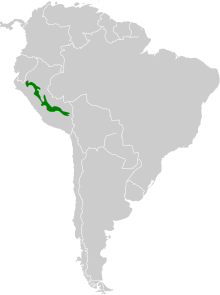Orange-brown shadow hummingbird
| Orange-brown shadow hummingbird | ||||||||||||
|---|---|---|---|---|---|---|---|---|---|---|---|---|

Orange-brown shadow hummingbird |
||||||||||||
| Systematics | ||||||||||||
|
||||||||||||
| Scientific name | ||||||||||||
| Phaethornis koepckeae | ||||||||||||
| Weske & Terborgh , 1977 |
The orange-brown shadow hummingbird ( Phaethornis koepckeae ) is a species of bird from the hummingbird family (Trochilidae). It is endemic to Peru . The IUCN assesses the population as near threatened .
features
The orange-brown shadow hummingbird reaches a body length of around 14 to 15 cm, with a straight beak being around 35 mm. The top of the head is blackish with a greenish sheen, the black edges on the feathers creating a scaly effect. The neck shimmers greenish bronze, which turns into a shiny black on the back. The rump is also black with a slight reddish-brown tint. The reddish brown upper tail-coverts have subterminally two to three black bands. The reins and ear covers are blackish with a reddish white line behind the eyes. A white-yellowish-brown line runs from the base of the beak under the area of the ears. The chin and throat are white and the sides are lined with yellowish-brown-gray cheek strips. The sides of the neck are grayish brown. The light reddish brown of the breast becomes darker on the sides and gradually merges into a rich reddish yellowish brown towards the back towards the abdomen, flanks and under tail coverts. The wing feathers and upper wing-coverts shine blackish, while the arm wings shine greenish bronze. The central flight feathers are predominantly green, but are graduated gray towards the rear and finally have white tips. The four wing feathers on the side shine dark green, which merges into a yellowish-brown to reddish-brown spot on the flag at the rear. The bill is predominantly black, with about two thirds of the lower bill being orange-red. The iris is dark brown and the color of the legs is flesh-colored. There is no sexual dimorphism .
distribution and habitat
This species is relatively common in isolated, scattered locations. Here it occurs in limited areas on remote mountain ridges at the foot of the eastern slopes of the Andes at altitudes between 450 and 1300 meters. She keeps herself in the lower strata on wet mountain forests. The ornithologist John Patton O'Neill reported occurrences in the valley of the Marañón in northern Peru, about 600 kilometers northwest of the first site in the remote mountains of Sira . Occasionally orange-brown shadow hummingbirds have also been spotted in typical forests of the lowlands up to the moss-covered cloud forests. The forests in the typical habitat of the hummingbird in the mountains of Sira are dominated by the ginger family ( Costus , Renealmia ), arrowroot family ( Calathea ) and banana family ( Heliconia ).
behavior
Not much is known about the behavior of this hummingbird at the moment.
Reproduction
Not much is known about the breeding behavior of this species. The biologist and professor Helen Jane Brockmann photographed a nest in the mountains of Sira on July 23, 1971. The small, cone-shaped nest was near the top on a frond of a disc flower plant , about four feet above the ground.
Vocalizations
The call consists of a haunting, lively series of short calls that sound like b'zee, b'zee, b'zee . There is also a rising tchwee or tchwing , as well as a decreasing, accelerated series of high notes.
Etymology and history of research
The holotype was collected on July 2, 1969 at an altitude of 860 meters by John Seddon Weske and John Whittle Terborgh in the mountains of Sira in the Departamento de Huánuco . Until its first description it was stored in the American Museum of Natural History. The term “Phaethornis” is derived from the Greek words “phaethōn Φαέθων ” for “the shining one, the shining one” and “órnis, όρνις ” for “bird”. The specific epithet "koepckeae" honors the ornithologist Maria Koepcke , who took part in the first two expeditions in the mountains of Sira and prepared four other bellows of this type.
literature
- John Seddon Weske, John Whittle Terborgh: Phaethornis koepckeae, a New Species of Hummingbird from Perú . In: The Condor . tape 79 , no. 2 , 1977, p. 143–147 ( online (PDF; 467 kB) [accessed April 10, 2013]).
- Thomas Scott Schulenberg, Douglas Forrester Stotz, Daniel Franklin Lane, John Patton O'Neill, Theodore Albert Parker III : Birds of Peru . Princeton University Press, Princeton, New Jersey 2007, ISBN 978-0-7136-8673-9 .
- James A. Jobling: Helm Dictionary of Scientific Bird Names . Christopher Helm, London 2010, ISBN 978-1-4081-2501-4 .
Web links
- Phaethornis koepckeae in the Red List of Threatened Species of the IUCN 2012. Posted by: BirdLife International, 2012.2. Retrieved April 10, 2013.
- BirdLife International: Species Factsheet - Koepcke's Hermit ( Phaethornis koepckeae ) . Retrieved April 10, 2013.
- Videos, photos and sound recordings of Koepcke's Hermit (Phaethornis koepckeae) in the Internet Bird Collection
- Orange-brown shadow hummingbird ( Phaethornis koepckeae ) at Avibase; Retrieved April 10, 2013.
- Phaethornis koepckeae in the Integrated Taxonomic Information System (ITIS). Retrieved April 10, 2013.
- xeno-canto: sound recordings - Koepcke's Hermit ( Phaethornis koepckeae )
